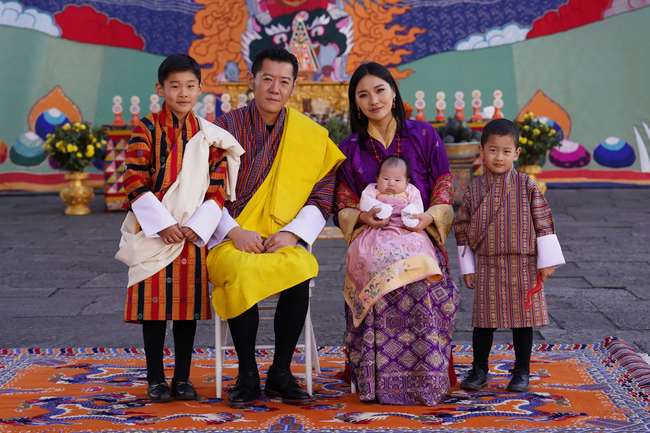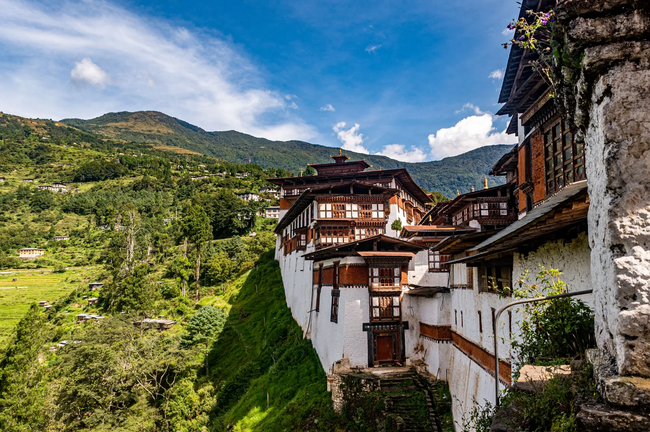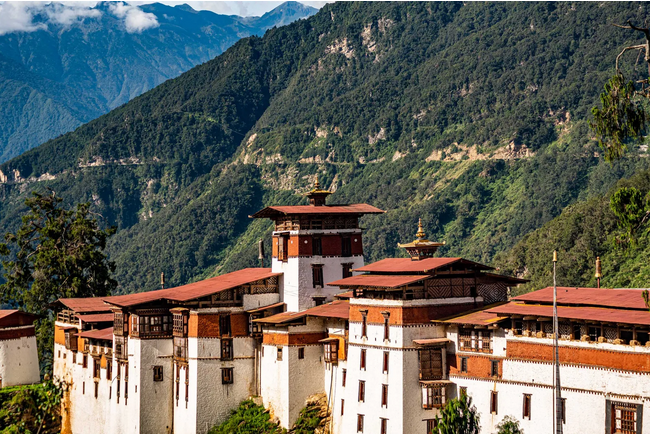 While most countries are losing many cultural elements, Bhutan is retaining most of theirs. This is largely due to their current king and the ones that came before him. The Ministry of Works and Human Settlement published the Bhutanese Architecture Guidelines in 2014—a comprehensive manual that makes it easy for architects, engineers, planners and craftsmen to pick up design elements before building something. “Bhutan stresses a lot on architecture as a part of its identity. It comes from the people, the royalty, everyone together. But nothing is a hard and fast rule. People are encouraged to follow the code and they do so with their own will,” says Rajni Chavda, who designed the Royal Thimphu College and two palaces for the Bhutanese royal family.
While most countries are losing many cultural elements, Bhutan is retaining most of theirs. This is largely due to their current king and the ones that came before him. The Ministry of Works and Human Settlement published the Bhutanese Architecture Guidelines in 2014—a comprehensive manual that makes it easy for architects, engineers, planners and craftsmen to pick up design elements before building something. “Bhutan stresses a lot on architecture as a part of its identity. It comes from the people, the royalty, everyone together. But nothing is a hard and fast rule. People are encouraged to follow the code and they do so with their own will,” says Rajni Chavda, who designed the Royal Thimphu College and two palaces for the Bhutanese royal family.
 With impressive proportions and the use of natural materials, the architecture mirrors the landscape of Bhutan. It is both grandiose and grounded. Every little detail comes together as part of a large puzzle. Columns can be square, circular or octagonal, with bow-shaped timber brackets placed upon them; their carvings represent royal customs. Balcony railings feature intricate paintings and their width is the same as the size of a hand. Windows are designed with multiple layers of traditional cornices and lintels. Sculptures of auspicious animals, such as the Snow Lion, and sometimes even small statues of deities are placed above the doors of palaces.
With impressive proportions and the use of natural materials, the architecture mirrors the landscape of Bhutan. It is both grandiose and grounded. Every little detail comes together as part of a large puzzle. Columns can be square, circular or octagonal, with bow-shaped timber brackets placed upon them; their carvings represent royal customs. Balcony railings feature intricate paintings and their width is the same as the size of a hand. Windows are designed with multiple layers of traditional cornices and lintels. Sculptures of auspicious animals, such as the Snow Lion, and sometimes even small statues of deities are placed above the doors of palaces.
 The Bhutanese people look up to the royals for inspiration. Her Majesty, Jetsun Pema, is a patron of the arts, and it’s because of her advocacy that the younger generation has started to appreciate traditional elements. This also applies to fashion and interior design.
The Bhutanese people look up to the royals for inspiration. Her Majesty, Jetsun Pema, is a patron of the arts, and it’s because of her advocacy that the younger generation has started to appreciate traditional elements. This also applies to fashion and interior design.
 The oldest standing buildings in Bhutan were built around the 7th century. The fact that the people have managed to preserve the essence of these relics—even in modern architecture—is nothing short of amazing. From fine restaurants to something as ubiquitous as a shopping mall or a mattress store—every building had a touch of Bhutan. Almost as if everyone in the country collectively decided to come together as a living and breathing entity—but without losing their individuality. It’s like wearing a uniform without compromising on your own personal style.
The oldest standing buildings in Bhutan were built around the 7th century. The fact that the people have managed to preserve the essence of these relics—even in modern architecture—is nothing short of amazing. From fine restaurants to something as ubiquitous as a shopping mall or a mattress store—every building had a touch of Bhutan. Almost as if everyone in the country collectively decided to come together as a living and breathing entity—but without losing their individuality. It’s like wearing a uniform without compromising on your own personal style.
 You can read the original article at www.architecturaldigest.in
You can read the original article at www.architecturaldigest.in


Another reason Bhutan has continued to build in its native, vernacular style is that there are no large development corporations that build in Bhutan. Unless it was made law, major developers would NEVER incorporate such elegant ornamentation!